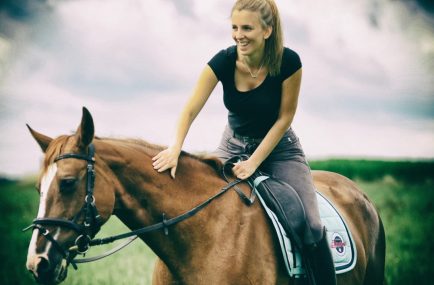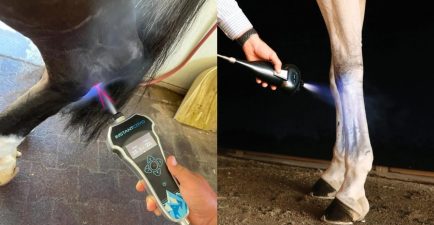If your horse has a respiratory problem, you might be wondering how to diagnose heaves in horses. This chronic breathing problem of horses is a difficult condition to manage. Let’s find out everything you need to know about how to diagnose heaves in horses!
What Is Heaves In Horses?
Heaves is a common respiratory condition of horses. The correct name for this disease is Recurrent Airway Obstruction (RAO), although you may also hear it referred to as broken wind, emphysema, or chronic obstructive pulmonary disorder (COPD).
RAO is a allergic respiratory disease of horses, similar to asthma in humans. The conditions is triggered when the horse inhales a pathogen, that causes inflammation within the respiratory tract following an allergic response.
There are two types of RAO in horses. The first occurs mainly during the winter months, and is associated by horses that spend long periods of time inside barns. Winter RAO is normally triggered by dust and mold spores from straw, hay, and other types of bedding.
Summer Pasture-associated RAO occurs during the summer months in horses that graze outside on pasture. It is triggered by an allergic response to grass pollens or molds.
Heaves tend to affect horses later in life, with the average age of diagnosis being around 9 years of age. Over one in ten adult horses have some form of allergen-induced respiratory disease.
What Are The Signs Of Heaves In Horses?
Horses with heaves will have a chronic cough, respiratory difficulty, and nasal discharge. The horse will show increased respiratory effort in an attempt to get enough air into the lungs – this leads to the characteristic ‘heave line’ along the side of the flank. This will be accompanied by flared nostrils and an increased respiratory rate.
Most horses with heaves will be lethargic, and will cough more when asked to exert themselves. A mild case of heaves in horses may manifest itself as a reduction in performance, while a severe case can be extremely debilitating to the horse.
How To Diagnose Heaves In Horses
If you suspect that your horse has heaves, one of the easiest ways to confirm the diagnosis is to remove any suspicious sources of allergens. If the horse shows an improvement in his breathing after this, it is highly likely that he has RAO.
For example, if the horse is kept stabled, fed on hay, and bedded on straw, turn him out to pasture for a few hours. You should notice a marked improvement in his breathing. However, episodes of heaves can quickly worsen, so if you have any concerns about your horse it is vital to contact your veterinary clinic as soon as possible.
Your veterinarian will carry out a full clinical examination of your horse, including listening to his chest and windpipe. He will assess the respiratory rate and effort of your horse, and discuss any recent changes to the management of your horse or exposure to potential allergens. Samples of blood and respiratory secretions may be taken to rule out other respiratory disorders.
A definitive diagnosis of RAO can be reached by assessing the response to treatment. Your veterinarian will inject your horse with a bronchodilator; this is a medication that relaxes the tiny airways within the lungs. You should notice a big improvement in your horse’s breathing within a matter of minutes.
Best Treatment For RAO In Horses
If RAO is diagnosed, your veterinarian will most likely recommend a long-term management strategy. This will include regular medication, as well as changes to your horse’s routine and accommodation to reduce exposure to allergens. It may be necessary for your horse to wear a nose net to reduce the inhalation of spores, and hay should be soaked to reduce dust.
The medication for RAO is often administered orally or via an equine inhaler. Your horse will need to be trained to accept the use of an inhaler, but this is worth the effort as it is the most effective way to treat RAO in horses. With good management and medication strategy, many horses with RAO can live long and comfortable lives.
Summary – How To Diagnose Heaves In Horses
So, as we have learned, the question of how to diagnose heaves in horses will depend on the clinical symptoms shown by your horse and the severity of the disease. One of the easiest ways to confirm the diagnosis is to remove any suspicious sources of allergens, and to assess if the horse shows an improvement in his breathing. A definitive diagnosis of RAO can be reached by assessing the response to treatment following the administration of a bronchodilator.
We’d love to hear your thoughts on how to diagnose heaves in horses! Have you ever cared for a horse with this chronic respiratory condition? Or maybe you’ve got some questions about the best medication for a horse with heaves? Leave a comment below and we’ll get back to you!
Original article: How To Diagnose Heaves In Horses – Best Horse Rider
www.royalequestriancollection.com – check our website to purchase and enjoy our products for your horses and you.

























